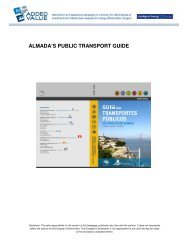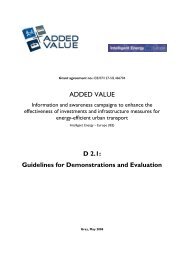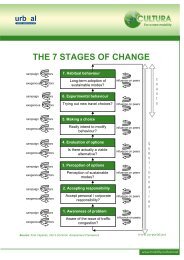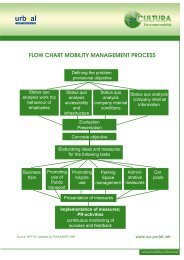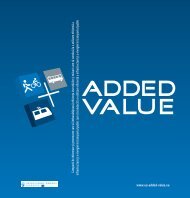SUMO - Eltis
SUMO - Eltis
SUMO - Eltis
You also want an ePaper? Increase the reach of your titles
YUMPU automatically turns print PDFs into web optimized ePapers that Google loves.
14<br />
evaluations in various types of projects (see also Chapter 1).<br />
<strong>SUMO</strong> can be used as a method to find measures for the two first stages on the four<br />
stage principle 4 . It can also be used as a tool to concretise when a systematic method is<br />
needed to specify target groups or draw up different proposals when moving from project<br />
directives to project planning 5 .<br />
<strong>SUMO</strong> can be used in both pre and post studies. Certain levels are suitable for both pre<br />
and post studies (Y, P and H, I), while the remainder are intended for post studies.<br />
Four different examples of how <strong>SUMO</strong> can be applied are presented at the end of the<br />
report (see also Section 3.5).<br />
Background<br />
Services<br />
Option offered<br />
Effects<br />
Y<br />
P<br />
A<br />
B<br />
C<br />
D<br />
E<br />
F<br />
G<br />
H<br />
sumo – System for Evaluation of Mobility Projects<br />
I<br />
<strong>SUMO</strong> analysis levels<br />
External factors<br />
A description of the external conditions for the measures. These are the same<br />
for all users.<br />
Person-related factors<br />
Information about the personal situation for different individuals, in order to<br />
divide them into target groups etc.<br />
Useful achievements<br />
Describes the effort invested in the measure, to change behaviour, such as meetings,<br />
material distributed, data systems introduced, decisions on travel policy, etc.<br />
Awareness of mobility service<br />
Number/percentage aware of the measures or the project.<br />
Degree of use of mobility service<br />
Number/percentage that show an interest in the project or measures, and use<br />
the mobility services.<br />
Satisfaction with the mobility service<br />
Measures how satisfied users are with the services offered.<br />
Acceptance of the offer<br />
Number/percentage that have accepted the options on offer and intend to<br />
change behaviour.<br />
Experimental individual behaviour<br />
Number/percentage that test a new mode of transport/new behaviour.<br />
Satisfaction with the offer<br />
Shows if people that have tested the offer are satisfied with it.<br />
Permanent individual behaviour<br />
Number/percentage that permanently change mode of transport or other<br />
behaviour in traffic.<br />
System impact<br />
Gives an estimate of how much vehicle mileage, emissions, accidents etc. have<br />
been reduced as a result of the change in behaviour.<br />
Figure 3.1 The different analysis levels in <strong>SUMO</strong><br />
4See the definition of the four stage principle in the Chapter 9, List of concepts.<br />
5See also the definition of project directives and project planning in Chapter 9, List of concepts.



